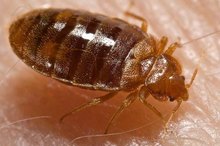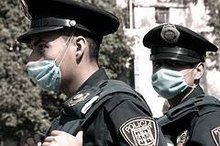What does fact checked mean?
At Healthfully, we strive to deliver objective content that is accurate and up-to-date. Our team periodically reviews articles in order to ensure content quality. The sources cited below consist of evidence from peer-reviewed journals, prominent medical organizations, academic associations, and government data.
- The Center for Disease Control and Prevention: Hand Washing
- The Mayo Clinic: Hand Washing Do's and Don'ts
The information contained on this site is for informational purposes only, and should not be used as a substitute for the advice of a professional health care provider. Please check with the appropriate physician regarding health questions and concerns. Although we strive to deliver accurate and up-to-date information, no guarantee to that effect is made.
How Does Hand Sanitizer Kill Bacteria?
Introduction
Disease-causing germs are present around you all the time. One main route of infection for these pathogens is your hands. Your hands are constantly touching the environment around you, picking up pathogens as they go, allowing these harmful substances to infect you or spread to others. To prevent this, the Center for Disease Control and Prevention recommends the regular washing of your hands with soap and water 1. Unfortunately, clean water and soap is not always available. In these cases the CDC recommends using an alcohol-based hand sanitizer, which is capable of killing most germs.
- Disease-causing germs are present around you all the time.
- In these cases the CDC recommends using an alcohol-based hand sanitizer, which is capable of killing most germs.
Active Ingredients
Ingredients in Hand Sanitizer
Learn More
Most hand sanitizers' active ingredients consist of either ethanol or isopropanol, both forms of alcohol. Alcohol kills most germs on contact without causing serious harm to the skin tissue, which makes it an effective active ingredient for hand sanitizers. Ethanol and isopropanol are antiseptics that kill germs by dissolving their essential proteins. This disrupts the normal cell activity of the germ, causing it to die.
- Most hand sanitizers' active ingredients consist of either ethanol or isopropanol, both forms of alcohol.
- Alcohol kills most germs on contact without causing serious harm to the skin tissue, which makes it an effective active ingredient for hand sanitizers.
Inactive Ingredients
To aid in application, and increase the skin benefits of the product, hand sanitizers often use inactive ingredients alongside ethanol or isopropanol. For example, humectants, such as glycerin, work as moisturizing agents. Humectants draw moisture from the surrounding environment and hold it close to the skin. Thickening agents, such as polyacrylic acid, may also be used to give hand sanitizers a gel like texture, which aids in the application and spreading of the product on the hands. A newer development in hand sanitizers is the use of fragrance oils to help lessen the smell of alcohol when applying the product.
- To aid in application, and increase the skin benefits of the product, hand sanitizers often use inactive ingredients alongside ethanol or isopropanol.
- Thickening agents, such as polyacrylic acid, may also be used to give hand sanitizers a gel like texture, which aids in the application and spreading of the product on the hands.
Effectiveness
Purell Hand Sanitizer Ingredients
Learn More
Hand sanitizers with at least a 60 percent inclusion of alcohol are effective in killing bacteria, including the Streptococcus bacteria, as well as the bacteria that cause tuberculosis (TB). Hand sanitizers are also effective against fungal infections, as well as enveloped viruses, such as the common cold and flu viruses.
Related Articles
References
- The Center for Disease Control and Prevention: Hand Washing
- Purell: What Everyone Should Know About Hand Hygiene Products
- The Mayo Clinic: Hand Washing Do's and Don'ts
- Centers for Disease Control and Prevention. CDC Statement for Healthcare Personnel on Hand Hygiene during the Response to the International Emergence of COVID-19. Updated March 14, 2020.
- Centers for Disease Control and Prevention. Chemical disinfectants. Updated September 18, 2016.
- Centers for Disease Control and Prevention. When and How to Wash Your Hands. Updated October 3, 2019.
- Vermeil T, Peters A, Kilpatrick C, Pires D, Allegranzi B, Pittet D. Hand hygiene in hospitals: anatomy of a revolution. J Hosp Infect. 2019;101(4):383-392. doi:10.1016/j.jhin.2018.09.003
- McEgan R, Danyluk MD. Evaluation of aqueous and alcohol-based quaternary ammonium sanitizers for inactivating Salmonella spp., Escherichia coli O157:H7, and Listeria monocytogenes on peanut and pistachio shells. Food Microbiol. 2015;47:93-98. doi:10.1016/j.fm.2014.11.010
- Inaida S, Shobugawa Y, Matsuno S, Saito R, Suzuki H. Delayed norovirus epidemic in the 2009-2010 season in Japan: potential relationship with intensive hand sanitizer use for pandemic influenza. Epidemiol Infect. 2016;144(12):2561-2567. doi:10.1017/S0950268816000984
- Stebbins S, Cummings DA, Stark JH, et al. Reduction in the incidence of influenza A but not influenza B associated with use of hand sanitizer and cough hygiene in schools: a randomized controlled trial. Pediatr Infect Dis J. 2011;30(11):921-926. doi:10.1097/INF.0b013e3182218656
- Azor-Martinez E, Yui-Hifume R, Muñoz-Vico FJ, et al. Effectiveness of a hand hygiene program at child care centers: A cluster randomized trial. Pediatrics. 2018;142(5):e20181245. doi:10.1542/peds.2018-1245
- Blaney DD, Daly ER, Kirkland KB, Tongren JE, Kelso PT, Talbot EA. Use of alcohol-based hand sanitizers as a risk factor for norovirus outbreaks in long-term care facilities in northern New England: December 2006 to March 2007. Am J Infect Control. 2011;39(4):296-301. doi:10.1016/j.ajic.2010.10.010
- Wilson AM, Reynolds KA, Jaykus LA, Escudero-Abarca B, Gerba CP. Comparison of estimated norovirus infection risk reductions for a single fomite contact scenario with residual and nonresidual hand sanitizers. Am J Infect Control. 2019;S0196-6553(19)30846-6. doi:10.1016/j.ajic.2019.09.010
- Centers for Disease Control and Prevention. Handwashing: Clean hands save lives. Updated January 14, 2020.
Writer Bio
Chris Sherwood is a professional journalist who after years in the health administration field and writing health and wellness articles turned towards organic sustainable gardening and food education. He now owns and operates an organic-method small farm focusing his research and writing on both organic gardening methods and hydroponics.









